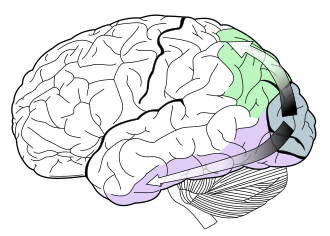Inferior temporal gyrus
(Redirected from Inferior temporal cortex)
Part of the temporal lobe of the brain
Inferior Temporal Gyrus
The inferior temporal gyrus is a region of the temporal lobe in the cerebral cortex of the brain. It is located on the lateral and ventral surfaces of the temporal lobe, below the middle temporal gyrus and above the fusiform gyrus. This gyrus plays a crucial role in the processing of visual stimuli and is involved in object recognition and the perception of complex stimuli such as faces.
Anatomy
The inferior temporal gyrus is situated in the lower part of the temporal lobe, extending from the temporal pole to the occipital lobe. It is bounded superiorly by the middle temporal sulcus and inferiorly by the occipitotemporal sulcus.
Connections
The inferior temporal gyrus is connected to various other regions of the brain, including the fusiform gyrus, parahippocampal gyrus, and the occipital lobe. These connections are essential for the integration of visual information and the formation of visual memories.
Function
The primary function of the inferior temporal gyrus is the processing of visual information. It is part of the ventral stream, also known as the "what pathway," which is involved in object recognition and form representation.
Role in Object Recognition
The inferior temporal gyrus is critical for the recognition of objects and faces. Damage to this area can result in visual agnosia, a condition where individuals are unable to recognize objects despite having intact vision.
Role in Face Perception
This gyrus is also involved in the perception of faces, a process that is crucial for social interactions. The fusiform face area, located in the fusiform gyrus, works closely with the inferior temporal gyrus in face recognition.
Clinical Significance
Lesions in the inferior temporal gyrus can lead to deficits in visual perception and recognition. Conditions such as prosopagnosia, or face blindness, can occur if the fusiform face area is affected.
Research and Imaging
Functional imaging studies, such as fMRI, have shown that the inferior temporal gyrus is activated during tasks involving object and face recognition. These studies help in understanding the neural mechanisms underlying visual perception.
Related Pages
Transform your life with W8MD's budget GLP-1 injections from $125.
W8MD offers a medical weight loss program to lose weight in Philadelphia. Our physician-supervised medical weight loss provides:
- Most insurances accepted or discounted self-pay rates. We will obtain insurance prior authorizations if needed.
- Generic GLP1 weight loss injections from $125 for the starting dose.
- Also offer prescription weight loss medications including Phentermine, Qsymia, Diethylpropion, Contrave etc.
NYC weight loss doctor appointments
Start your NYC weight loss journey today at our NYC medical weight loss and Philadelphia medical weight loss clinics.
- Call 718-946-5500 to lose weight in NYC or for medical weight loss in Philadelphia 215-676-2334.
- Tags:NYC medical weight loss, Philadelphia lose weight Zepbound NYC, Budget GLP1 weight loss injections, Wegovy Philadelphia, Wegovy NYC, Philadelphia medical weight loss, Brookly weight loss and Wegovy NYC
|
WikiMD's Wellness Encyclopedia |
| Let Food Be Thy Medicine Medicine Thy Food - Hippocrates |
Medical Disclaimer: WikiMD is not a substitute for professional medical advice. The information on WikiMD is provided as an information resource only, may be incorrect, outdated or misleading, and is not to be used or relied on for any diagnostic or treatment purposes. Please consult your health care provider before making any healthcare decisions or for guidance about a specific medical condition. WikiMD expressly disclaims responsibility, and shall have no liability, for any damages, loss, injury, or liability whatsoever suffered as a result of your reliance on the information contained in this site. By visiting this site you agree to the foregoing terms and conditions, which may from time to time be changed or supplemented by WikiMD. If you do not agree to the foregoing terms and conditions, you should not enter or use this site. See full disclaimer.
Credits:Most images are courtesy of Wikimedia commons, and templates, categories Wikipedia, licensed under CC BY SA or similar.
Translate this page: - East Asian
中文,
日本,
한국어,
South Asian
हिन्दी,
தமிழ்,
తెలుగు,
Urdu,
ಕನ್ನಡ,
Southeast Asian
Indonesian,
Vietnamese,
Thai,
မြန်မာဘာသာ,
বাংলা
European
español,
Deutsch,
français,
Greek,
português do Brasil,
polski,
română,
русский,
Nederlands,
norsk,
svenska,
suomi,
Italian
Middle Eastern & African
عربى,
Turkish,
Persian,
Hebrew,
Afrikaans,
isiZulu,
Kiswahili,
Other
Bulgarian,
Hungarian,
Czech,
Swedish,
മലയാളം,
मराठी,
ਪੰਜਾਬੀ,
ગુજરાતી,
Portuguese,
Ukrainian
Contributors: Prab R. Tumpati, MD








